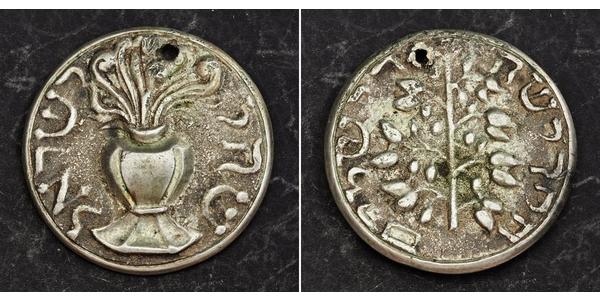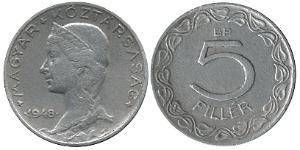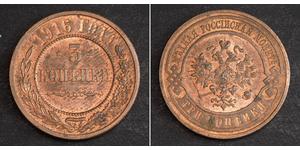(продана за $42.0)
1850s, Germany, Silesia. Silver "Gorlitz Shekel / Censer Piece" Toiken Coin. XF-
Mint Year: ca. 1850s Denomination: Gorlitz Shekel / Censer Piece - Pilgrim´s Token / Medal Condition: Cast (as made) and pierced (in order to be worn), minor greenish deposits, otherwise XF for thiy type! Reference: Schier page 205 var. (there are many varieties of this type, most of them by unknown designer and mint!) Weight: 10.68gm Diameter: 29mm Material: Silver
Obverse: Burning censer. Hebrew legend ("Shekel Israel") around..
Reverse: Flowering Rod of Aaron. Hebrew legend ("Jerusalem the Holy") around.
This type of medallic Shekels may have begun as souvenirs made for pilgrims, loosely based on coins of the First Revolt coins with their chalice design. The rest of the design is wholly imaginary.
Aaron's rod refers to any of the staves carried by Moses's brother, Aaron, in the Torah. The Bible tells how, along with Moses's rod, Aaron's rod was endowed with miraculous power during the Plagues of Egypt that preceded the Exodus. There are two occasions where the Bible tells of the rod's power.
In the culture of the Israelites, the rod (Hebrew: מַטֶּה maṭṭeh) was a natural symbol of authority, as the tool used by the shepherd to correct and guide his flock (Psalm 23:4). Moses's rod is, in fact, cited in Exodus 4:2 as carried by him while he tended his sheep; and later (Exodus 4:20) becomes his symbol of authority over the Israelites (Psalm 2:9, Psalm 89:32, Isaiah 10:24 and 11:4, Ezekiel 20:37). The rods of both Moses and Aaron were endowed with miraculous power during the Plagues of Egypt (Exodus 7:17, 8:5, 8:16-17, 9:23, and 10:13); God commanded Moses to raise his rod over the Red Sea when it was to be parted (Exodus 14:16) and in prayer over Israel in battle (Exodus 17:9); Moses brings forth water from a stone using his rod (Exodus 17, Numbers 20:11).
Aaron's rod, however, is cited twice as exhibiting miraculous power on its own, when not physically in the grasp of its owner. In Exodus 7 (Parshat Va'eira in the Torah), God sends Moses and Aaron to the Pharaoh once more, instructing Aaron that when the Pharaoh demands to see a miracle, he is to "cast down his rod" and it will become a serpent. When he does so, the Pharaoh's sorcerers counter by similarly casting down their own rods, which also become serpents, but Aaron's rod/serpent swallows them all. "The Pharaoh's heart is stubborn" and he chooses to ignore this bit of symbolic warning, and so the Plagues of Egypt ensue. Notably, this chapter begins with God telling Moses, "Behold, I have made you as God to the Pharaoh and your brother Aaron will be your prophet." As God transmits his word through his prophets to his people, so Moses will transmit God's message through Aaron to the Pharaoh. The prophet's task was to speak God's word on God's behalf. He was God's "mouth". (Exodus 4:15-16)
In Numbers 17, Korah's rebellion against Moses' proclamation of the tribe of Levi as the priesthood has been quashed and the entire congregation's ensuing rebellion has resulted in a plague, ended only by the intercession of Moses and Aaron. In order to "stop the complaints" of the Israelites, God commands that each of the Twelve Tribes provide a rod; and only that of the tribe chosen to become priests will miraculously sprout overnight. Aaron provides his rod to represent the tribe of Levi, and "it put forth buds, produced blossoms, and bore ripe almonds" (Numbers 17:8), as an evidence of the exclusive right to the priesthood of the tribe of Levi. In commemoration of this decision it was commanded that the rod be put again "before the testimony" (Numbers 17:10). According to tradition, the rod of Aaron bore sweet almonds on one side and bitter on the other; if the Israelites followed the Lord, the sweet almonds would be ripe and edible, but if they were to forsake the path of the Lord, the bitter almonds would predominate.[citation needed]
A book of the Christian Bible seems to assert (Hebrews 9:4) that the rod was kept in the Ark of the Covenant.
The Bible ascribes similar miraculous powers to the Rod of Aaron and to the staff of Moses (compare, for example, Exodus 4:2 et seq. and 7:9). The Haggadah goes a step further, and entirely identifies the Rod of Aaron with that of Moses.[1] Thus, the Midrash Yelammedenu states that:
the staff with which Jacob crossed the Jordan is identical with that which Judah gave to his daughter-in-law, Tamar (Genesis 32:10, 38:18). It is likewise the holy rod with which Moses worked (Exodus 4:20, 21), with which Aaron performed wonders before Pharaoh (Exodus 7:10), and with which, finally, David slew the giant Goliath (I Samuel 17:40). David left it to his descendants, and the Davidic kings used it as a scepter until the destruction of the Temple, when it miraculously disappeared. When the Messiah comes it will be given to him for a scepter in token of his authority over the heathen.
It was made of sapphire, weighed forty seahs (a seah = 10.70 pounds), and bore this inscription דצכ עדש באחב, which is composed of the initials of the Hebrew names of the Ten Plagues (Tan., Waëra 8, ed. Buber).

|
Добавил:
anonymous 2018-05-06 |
3 Копейка Российская империя (1720-1917) Медь Николай II (18 ...
в группе 32 монет / 22 цен
⇑















-300-150-dhwKbzbigkAAAAFPJvyA8InM.jpg)







